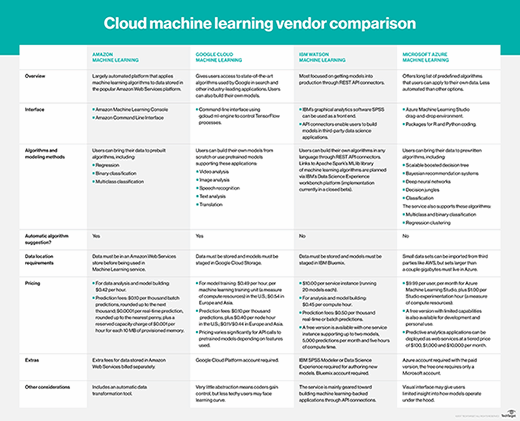Machine learning platforms comparison: Amazon, Azure, Google, IBM
The platform war over machine learning tools is heating up. Use our features comparison chart to see how four top vendors stack up and help you decide which is right for your enterprise.
Data scientists who want to build machine learning models and put them into production have no shortage of available tools, but choosing the right one comes with some thorny decisions.
The chart below breaks down some of the most popular machine learning platforms by their key features and price tags. Note that many open source tools are available for machine learning, as well as other vendor offerings, but we focused exclusively on vendor cloud platforms that span the entire machine learning lifecycle from data ingestion to model development to production.
The market for machine learning platforms is heating up, and all of the leading vendors are looking to nab their share. Analyst firm Forrester expects this market to grow at a rate of 15% annually through 2021.
Several vendors have beefed up their offerings in recent months and now offer simple, cloud-based platforms for getting started with machine learning and developing models that can quickly be put into production.
But these machine learning platforms all come with their own downsides. There is a significant risk of vendor lock-in with each. They generally require users to bring their data to the broader cloud platform. Once all of an enterprise's data is located in one vendor's cloud, it's difficult for that business to use another vendor's services or to use open source tools for other tasks.

Since it's still early days for these types of platforms, it's hard to know which vendors will ultimately develop the best offerings. Users need to understand the various pros and cons of each before deciding to hop in with all their data. The machine learning platform war is on -- use the comparison chart to help your enterprise navigate the battlefield. Click on the diagonal arrows in the top-right corner to view the full chart.







